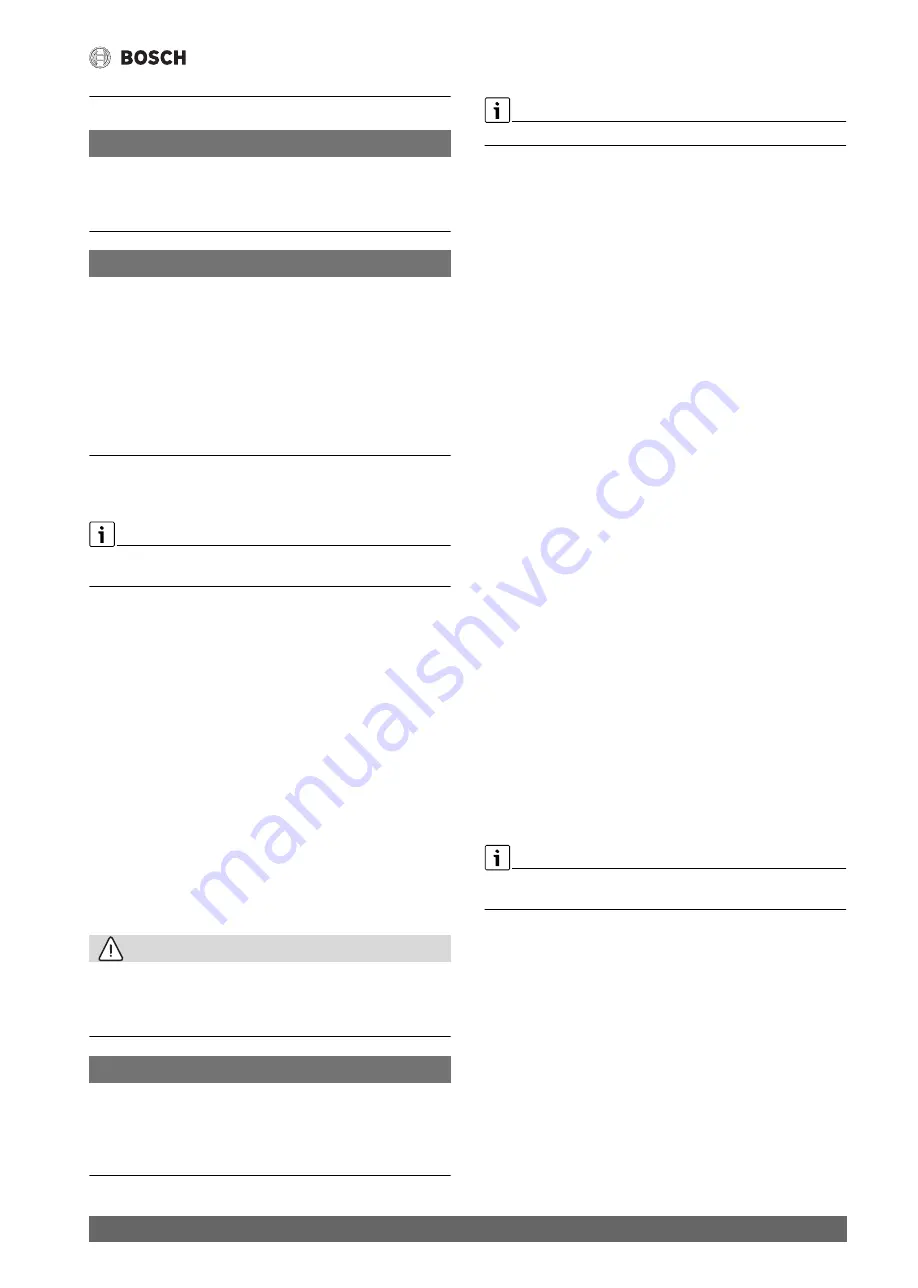
Commissioning
33
Uni Condens 8000 F – 6720867056 (2016/10)
8
Commissioning
NOTICE:
System damage through incorrect burner adjustment
(overloading)!
▶ Make sure that the value set does not exceed the rated heat output
Qn(Hi) stated on the data plate.
NOTICE:
Risk of boiler damage through contaminated combustion air!
▶ Never operate the boiler in very dusty conditions, e.g. if building work
is taking place at the installation location.
▶ Ensure adequate air supply.
▶ Never use or store chlorinated cleaning agents or halogenated
hydrocarbons (as contained in spray cans, solvents or cleaning
agents, paints and adhesives, for example) at the installation
location.
▶ A burner contaminated during building work must be cleaned before
commissioning.
▶ Complete the commissioning report (
chapter 14.4, page 42).
8.1
Purge the heating system
If the heating system contains several heating circuits, these must be
purged one after the other.
To prevent contamination in the boiler, flush the heating system prior to
commissioning.
▶ Purge the system prior to connection to the boiler.
-or-
▶ Isolate the heating flow and return at the boiler.
▶ Connect the heating flow to a water connection.
▶ Connect hose to the heating return of the heating system.
▶ Route hose from the heating return to a drain.
▶ Open connected consumers (e.g. radiators).
▶ Purge the heating system with potable water until clear water
emerges from the heating return.
▶ Drain the heating system down.
8.2
Carrying out a leak test
The test pressure depends on the actual pressure in the heating system
and should be 1.3 times the prevailing pressure or at least 1 bar.
▶ Carry out a leak test according to locally applicable regulations.
8.3
Filling the heating system
CAUTION:
Health risk through contaminated drinking water!
▶ Observe all country-specific regulations and standards regarding the
prevention of drinking water contamination. In Europe, observe
standard EN 1717.
NOTICE:
System damage due to temperature stresses!
▶ Only fill the heating system when cold
(the flow temperature must not exceed 40 °C).
▶ During operation, only fill the heating system via the filling facility in
the heating system pipework (return).
Open the automatic air vent valve only briefly for ventilation.
The fill and top-up water quality must comply with the specifications in
the operator's log supplied (
chapter 4.6, page 14).
The pH value of the heating water increases after the heating system has
been filled.
▶ During initial maintenance (after three to six months) check whether
the pH value of the heating water has settled down.
▶ Adjust the pre-charge pressure of the expansion vessel to the
required pressure (only for sealed unvented systems).
▶ Open the mixing and shut-off valve on the hot water side.
▶ Fill the heating system slowly using an on-site filling device and
observe the pressure gauge whilst doing so.
▶ Vent the heating system via the radiator air vent valves.
If the operating pressure drops as a result of venting the system:
▶ Top up the system with water.
▶ Carry out a tightness test in accordance with locally applicable
regulations.
▶ After the tightness test, reinstate all components that were taken out
of operation.
▶ Ensure that all pressure, control and safety equipment is functioning
correctly.
Once the boiler has been tested for tightness and no leaks have been
found:
▶ Set the correct operating pressure.
▶ Close the automatic air vent valve.
8.4
Setting the minimum and maximum pressure limiters
(accessories)
8.4.1
Setting the maximum pressure limiter
The maximum pressure limiter must be set in such a way that the
pressure relief valve is prevented from responding. To achieve this, a
safety margin of 0.2 bar compared to the excess pressure of the
pressure relief valve must be maintained. The maximum excess pressure
of the boiler's pressure relief valve depends on the size of the boiler
(
Example:
Pressure relief valve excess pressure: P
SV
= 5 bar
Setting value, maximum pressure limiter: 5 bar - 0.2 bar = 4.8 bar
To set the pressure limiter, refer to documentation of the pressure
limiter.
8.4.2
Setting the minimum pressure limiter
The minimum pressure limiter must be set in such a way that no steam
bubbles form in the boiler, and that the boiler still operates safely.
This setting depends on the system conditions and the siting situation of
the boiler system.
A minimum value of 1 bar must always be set for rooftop infrastructure
centres. We recommend using a low water indicator with rooftop
infrastructure centres.
For the setting value, the boiling pressure associated with the setting
value of the high limit safety cut-out is relevant as is the consumer at the
highest geodetic level above the boiler.
The available geodetic level calculated lies between the highest point of
the consumer and the installation location of the pressure maintaining
system.
Содержание Uni Condens 8000 F
Страница 45: ......
Страница 46: ......
Страница 47: ......
Страница 48: ...Bosch Thermotechnik GmbH Junkersstrasse 20 24 D 73249 Wernau www bosch thermotechnology com ...
















































